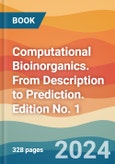Until recently, the field of computational bioinorganics has been governed by the application of quantum mechanical approaches. The emergence of metal-related biomolecular fields and increased computational capabilities have enabled the development of novel artificial metalloenzymes, new metallodrugs strategies, and advanced biosensor technologies.
Computational Bioinorganics: From Description to Prediction provides a state-of-the-art overview of the field, covering a wide range of computational approaches, strategies, and applications. Contributions from a team of experts in bioinorganic chemistry discuss recent advances in sequence and structural bioinformatics, multi-scale strategies, large-scale molecular dynamics, and more. Divided into three parts, the book opens with a thorough introduction to computational bioinorganic chemistry, followed by an extensive summary of the computational methods available in bioinorganic chemistry. The book concludes with a series of detailed reviews of various applications, including computational studies of metal-mediated folding and computer-aided metalloenzyme design. - Discusses the difference between fields in which bioinorganics are well established and those under active development - Describes the complexities of biometallic systems and how computation can be applied to bioinorganic systems - Presents the recent advances, advantages, and limitations of each computational approach covered - Covers a variety of applications of computational bioinorganics, including prediction of metal binding sites and characterization of the interaction of metallodrugs with biomolecules.
Edited by a recognized leader in the field, Computational Bioinorganics: From Description to Prediction is an essential resource for academic and industrial researchers working in the fields of bioinorganic chemistry, coordination chemistry, biochemistry, computational chemistry, biophysics, bioinformatics, and protein engineering.
Table of Contents
Chapter 1: Bioinorganics: Computation & experiments
Chapter 2: Metal binding site predictions
Chapter 3: Quantum Mechanics & oxidation state
Chapter 4: Computation & Spectroscopy
Chapter 5: Multi-scale computational modeling for the discovery and characterization of new metalloenzyme-catalyzed reactions
Chapter 6: Force Fields and Metals
Chapter 7: Modelling Thermally Activated Processes
Chapter 8: Metal folding
Chapter 9: Metallodrugs
Chapter 10: Design of Metalloenzymes
Chapter 11: Multiscale Study: the case of Aluminium








